Science Olympiad Model Test Paper - 1 - Class 8 PDF Download
Note: The questions provided in this document are similar to the questions that were asked in the actual Olympiad exam. So, we recommend you study these for your Olympiad preparation.
Logical Reasoning Section
Q1: There is a specific connection between the numbers on both sides of ": :". Determine the relationship in the left pair and identify the missing number. 343 : 7 : : 729 : ?(a) 6
(b) 8
(c) 9
(d) 10
 View Answer
View Answer 
Ans: (c)
- To find the missing number, we first analyze the left pair: 343 and 7.
- Notice that 343 is equal to 7 raised to the power of 3 (7 x 7 x 7 = 343).
- Now, looking at the right pair, 729 can be expressed as 9 raised to the power of 3 (9 x 9 x 9 = 729).
- Thus, following the same pattern, the missing number is 9, which is the cube root of 729.
Q2: Which of the following options will complete the given sequence? ABC, GHI, MNO, ?
(a) PQR
(b) QRS
(c) RST
(d) STU
 View Answer
View Answer 
Ans: (d)
- The series consists of groups of three consecutive letters from the alphabet.
- ABC is followed by GHI, which skips four letters (DEF).
- Then MNO follows, skipping four letters (JKL).
- Continuing this pattern, the next group should be STU, skipping four letters (PQR).
Q3: The question figure is embedded in one of the answer figures given below. You have to find out that answer figure and mark the answer.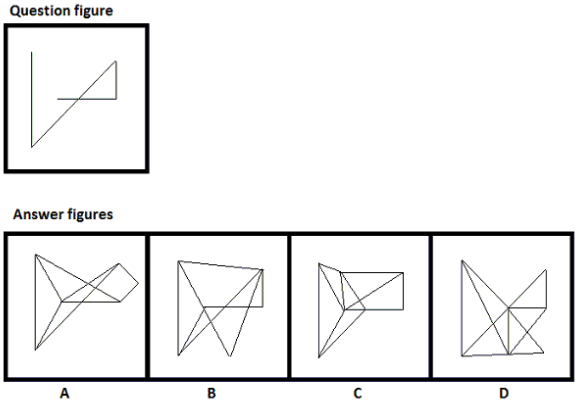
(a) A
(b) B
(c) C
(d) D
 View Answer
View Answer 
Ans: (b)
Question figure is embedded in answer figure B.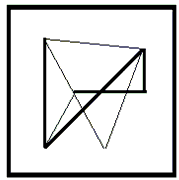
Q4: Choose the appropriate option which resembles the perfect mirror image of the following figure:
(a) 
(b) 
(c) 
(d) 
 View Answer
View Answer 
Ans: (a)
To get the mirror image, we need to flip it horizontally.
Out of the given options, figure 1 is the only image that is horizontally flip of the image given in the question.
Q5: One of the answer figures A, B, C, or D contains the mirror image of the question figure. Find the correct mirror image of the question figure.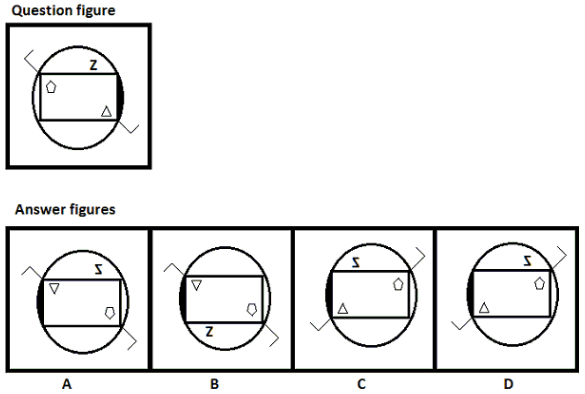
(a) A
(b) B
(c) C
(d) D
 View Answer
View Answer 
Ans: (c)
Answer figure C is the correct mirror image of the question figure.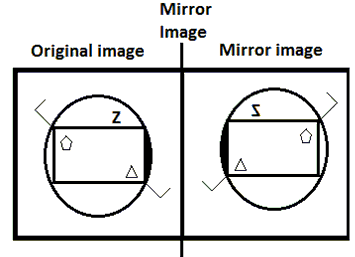
Q6: How many pairs of letters can be found in the word "INTERVIEW" that have the same number of letters between them as they do in the English alphabet?
(a) 2
(b) 3
(c) 4
(d) 5
 View Answer
View Answer 
Ans: (a)
- To solve this, we need to look for pairs of letters in "INTERVIEW" that have the same spacing as in the English alphabet.
- For example, the letters 'I' and 'N' are 5 letters apart in the word and also 5 letters apart in the alphabet.
- After checking all possible pairs, we find that there are only 2 such pairs that meet this criterion.
- Thus, the answer is 2 pairs.
Q7: In a specific coding system, the word HEAR is represented as 160. How is the word BORN represented in that same coding system?
(a) 180
(b) 300
(c) 245
(d) 210
 View Answer
View Answer 
Ans: (c)
- To decode the word HEAR, we assign each letter a numerical value based on its position in the alphabet: H=8, E=5, A=1, R=18.
- Adding these values gives us: 8 + 5 + 1 + 18 = 32.
- Then, we multiply this sum by 5 (32 x 5 = 160), which is how HEAR is coded.
- For BORN, we calculate: B=2, O=15, R=18, N=14. Adding these gives us: 2 + 15 + 18 + 14 = 49.
- Multiplying 49 by 5 results in 245 (49 x 5 = 245), which is the code for BORN.
Q8: Reptile is to lizard as flower is to
(a) petal
(b) stem
(c) daisy
(d) bud
 View Answer
View Answer 
Ans: (c)
A lizard is a type of reptile; a daisy is a type of flower. Choices 1 and 2 are incorrect because a petal and a stem are parts of a flower, not types of flowers. Choice 4 is incorrect because bud is a small growth at the tip or on the side of a stem that later develops into a flower, leaf, or branch.
Q9: In a line of boys, Vinay is positioned 10th from the right side and Sunil is 15th from the left side. After they switch places, Vinay is now 17th from the right side. What is the total number of boys in the line?
(a) 30
(b) 31
(c) 32
(d) 33
 View Answer
View Answer 
Ans: (b)
- Let the total number of boys be represented as N.
- When Vinay is 10th from the right, there are N - 10 boys to his left.
- Sunil is 15th from the left, meaning there are 15 - 1 = 14 boys to his left.
- After they switch, Vinay is now 17th from the right, which means there are N - 17 boys to his left.
- Setting the two left counts equal gives us the equation: N - 10 = 14 + 17, leading to N = 31.
Q10: Rashmi walked 4 m towards the North, then turned West and walked 3 m, after that she turned North again and walked 2 m, and finally turned East and walked 11 m. What is her distance from the starting point now?
(a) 10 m
(b) 15 m
(c) 12 m
(d) 18 m
 View Answer
View Answer 
Ans: (a)
- Rashmi starts at a point and moves 4 m North.
- Then she turns West and moves 3 m.
- Next, she turns North again and walks 2 m.
- Finally, she turns East and walks 11 m.
- To find her distance from the starting point, we can visualize her path and calculate the total displacement, which results in 10 m from the starting point.
Science Section
Q11: Study the diagram given below and identify the separation method.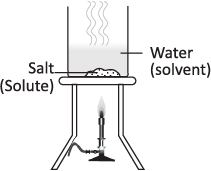 (a) Distillation
(a) Distillation (b) Evaporation
(c) Condensation
(d) Separating funnel
 View Answer
View Answer 
Ans: (b)
The name of the separation method is evaporation. It is the process of changing a liquid into vapours. Salt is soluble in water. So, on evaporation, water will turn to vapour while salt crystals remain in the container.
Q12: Filtration is the separation technique used when –
(a) One component of a mixture is soluble in water and other is insoluble in water.
(b) Both the components of a mixture are soluble in water.
(c) Both the components of a mixture are insoluble in water.
(d) Both the components of a mixture are sparingly soluble in water.
 View Answer
View Answer 
Ans: (a)
Filtration is the process in which insoluble substances from the liquid can be removed or separated by using filter paper. The liquid which is filtered is known as filtrate and the insoluble particles left in the filter paper is known as residue.
Q13: Which of the following are the properties of nonmetals?
I. They have low densities.
II. They have low melting points.
III. They are poor conductors of electricity.
(a) I and II only
(b) II and III only
(c) I and III only
(d) All of the above
 View Answer
View Answer 
Ans: (d)
Non-metals have low densities, low melting points and are poor conductors of electricity.
Q14: In a science class, Sneha’s science teacher told her that water should not be used to control the fire involving electrical equipment. This is because:
(a) Water is a liquid, so it is difficult to carry.
(b) Water is an insulator.
(c) Water is a good conductor of electricity and may result in electric shock.
(d) Water is not available easily.
 View Answer
View Answer 
Ans: (a)
In case of fires produced by electric short circuit or electric equipment, water is not used at all because water is a good conductor of electricity and may result in electric shock.
Q15: The dry leaves can catch fire easily as compared to green leaves though both are from the same plant. This is because:
(a) Green leaves have chlorophyll.
(b) Green leaves have water and other elements so they need more heat to reach ignition temperature.
(c) Dry leaves have low ignition temperature than green leaves.
(d) Option (b) and (c)
 View Answer
View Answer 
Ans: (d)
Dry leaves have low ignition temperature than heap of green leaves. So, to ignite the green leaves, we have to heat them up to ignition temperature of their constituents which is comparatively high. Hence, it is easier to ignite dry leaves than green leaves.
Q16: Rajat and Ronit were doing an experiment in which water was to be heated in a beaker. Rajat kept the beaker with water near the wick in the yellow part of the candle flame. Ronit kept the beaker with water in the outermost part of the flame. Whose water will get heated early?
(a) Rajat’ beaker
(b) Ronit’ beaker
(c) There will not be any effect of heat of candle flame.
(d) Water in both the beakers will take same time to get heated.
 View Answer
View Answer 
Ans: (b)
As outermost flame is hotter than the middle part or yellow flame, so water in beaker of Ronit will be heated in a shorter time.
Q17: Match the columns and choose the correct option.
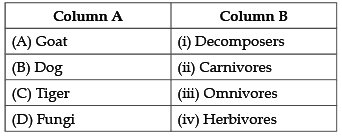 (a) (A) – (ii), (B) – (iii), (C) – (i), (D) – (iv)
(a) (A) – (ii), (B) – (iii), (C) – (i), (D) – (iv)
(b) (A) – (iv), (B) – (iii), (C) – (ii), (D) – (i)
(c) (A) – (iii), (B) – (ii), (C) – (iv), (D) – (i)
(d) (A) – (i), (B) – (ii), (C) – (iv), (D) – (iii)
 View Answer
View Answer 
Ans: (b)
Goat – Herbivores,
Dog – Omnivores,
Tiger – Carnivores,
Fungi – Decomposers.
Q18: Read the following statements and choose the accurate option. Statement I: The laws of reflection apply in regular reflection. Statement II: The laws of reflection apply in irregular reflection.
(a) Statement I is correct.
(b) Statement II is correct.
(c) Both statements I and II are correct.
(d) Both statements I and II are incorrect.
 View Answer
View Answer 
Ans: (c)
- Statement I is true because in regular reflection, such as with a smooth surface, the laws of reflection are indeed followed.
- Statement II is also true; even in irregular reflection, the laws still apply, but the reflection is scattered.
- Thus, both statements are correct, making option (c) the right choice.
- Understanding this helps clarify how light behaves on different surfaces.
Q19: Which of the following represents the appropriate environmental conditions for setting the upper fixed point and the lower fixed point on a thermometer? Upper Fixed Point / Lower Fixed Point
(a) Steam from boiling water / Ice at minimum temperature
(b) Boiling water / Melting ice
(c) Steam from boiling water / Melting ice
(d) Boiling water / Ice at freezing temperature
 View Answer
View Answer 
Ans: (c)
- The upper fixed point of a thermometer is determined by the steam from boiling water, which is a consistent reference point.
- The lower fixed point is established using melting ice, which is also a reliable standard for temperature measurement.
- Option (c) correctly identifies these two conditions, making it the right choice.
- Other options either mix up the conditions or use incorrect terms, which do not accurately represent the calibration process.
Q20: Choose the incorrect statement about Biosphere Reserve?
(a) It involves conservation of wildlife of the area.
(b) It prevents the commercial exploitation of the area.
(c) It keeps a record of all the endangered animals of the area.
(d) It maintains the lifestyle of the tribal people living in the area.
 View Answer
View Answer 
Ans: (c)
Biosphere reserve is a large protected area which is meant for the conservation of all life forms found in a particular area. It prevents the commercial exploitation of the area.
Q21: IUCN stands for:
(a) Indian Union for Conservation of Nature and Natural resources.
(b) International Union for Conservation of Nature and Natural resources.
(c) International Union for Controlling the Nature and National resources.
(d) International Unity for Controlling the Nature and Natural resources.
 View Answer
View Answer 
Ans: (b)
IUCN stands for International Union for Conservation of Nature and Natural resources.
Q22: Identify the accurate statement(s) regarding tornadoes:
I. Violent tornado can travel at a speed of 300 km/h.
II. Tornado may form within cyclones.
III. Tornado is a dark funnel-shaped cloud that reaches from sky to ground.
(a) I only
(b) I and II only
(c) II and III only
(d) I, II and III
 View Answer
View Answer 
Ans: (d)
- Statement I is true as a violent tornado can indeed reach speeds of up to 300 km/h.
- Statement II is also correct because tornadoes can form within cyclones.
- Statement III accurately describes a tornado as a dark funnel-shaped cloud that extends from the sky to the ground.
- Since all three statements are correct, the answer is (d) I, II and III.
Q23: An object at rest is allowed to fall from a tall tower. Which of the following statements is true for the motion of the object upon its release?
(a) The acceleration of the object increases.
(b) The acceleration of the object decreases.
(c) The acceleration of the object remains same.
(d) The velocity of the object remains same.
 View Answer
View Answer 
Ans: (c)
- The object starts from rest and falls due to gravity.
- During the fall, the acceleration due to gravity is constant at approximately 9.8 m/s².
- This means that the acceleration does not change; it remains the same throughout the fall.
- Thus, the correct statement is that the acceleration of the object remains same.
Q24: Select the incorrect statements regarding the function of a fuse:
I. It is used to prevent the current from coming out from the neutral terminal.
II. It is used to prevent damage to electrical appliances by melting, whenever current exceeds the maximum value.
III. It is used to prevent the current from coming out from the live terminal.
IV. It is used to allow current to discharge to the Earth.
(a) I and III only
(b) I, III and IV only
(c) II, III and IV only
(d) II and III only
 View Answer
View Answer 
Ans: (b)
- The function of a fuse is to protect electrical appliances by melting when the current exceeds a certain limit, preventing damage.
- Statement I is incorrect because a fuse does not prevent current from coming out of the neutral terminal; it is designed to interrupt the circuit when necessary.
- Statement III is also incorrect as a fuse does not prevent current from the live terminal; it is meant to break the circuit in case of overload.
- Statement IV is incorrect because a fuse does not allow current to discharge to the Earth; that is the role of a grounding system.
Q25: Why do animals like frog and fish produce hundreds of eggs while hens and humans produce one egg at a time?
(a) Eggs of frog and fish are preyed by predators and are exposed to environment.
(b) In frogs and fish, internal fertilisation occurs.
(c) Eggs of hens and humans are exposed to external environment.
(d) Eggs of frogs and fish are produced inside the mother's body and are hence protected.
 View Answer
View Answer 
Ans: (a)
Fish lay a large number of eggs because only a few of them, out of thousands, will be fertilised and produce a fish. This is because they are fertilised outside of the body and are highly sensitive to temperature changes and external factors including predators.
Q26: Which area of the flame do goldsmiths utilize to melt silver and gold?
(a) Middle zone
(b) Outermost zone
(c) Innermost zone
(d) Either A or C
 View Answer
View Answer 
Ans: (b)
- The outermost zone of the flame is the hottest part, which is ideal for melting metals like silver and gold.
- Goldsmiths prefer this zone because it provides the necessary high temperature for effective melting.
- The middle zone and innermost zone are not as effective for this purpose.
- Thus, the correct choice is the outermost zone where the flame is hottest.
Q27: Which microorganism causes rust of wheat in leaves?
(a) Alga
(b) Fungus
(c) Bacterium
(d) Virus
 View Answer
View Answer 
Ans: (b)
Wheat-leaf rust is a fungal disease that affects wheat. The fungus is an obligate parasite, which is capable of producing infectious urediniospores as long as infected leaf tissue remains alive.
Q28: Some common methods of food preservation are given below:
P: Preservation by sugar
Q: Heat and cold treatments
R: Preservation by using chemicals
S: Preservation by oil and vinegar
Which of the statements is incorrect regarding methods of food preservation?
(a) P increases the moisture content which inhibits the growth of bacteria
(b) R uses sodium benzoate and sodium metabisulphite
(c) Q is involved in the pasteurisation of milk
(d) S is used in the preservation of fruits and vegetables in the form of pickles.
 View Answer
View Answer 
Ans: (a)
Jams, jellies and squashes are preserved by sugar. Sugar reduces the moisture content which inhibits the growth of bacteria which spoil food.
Q29: Which of the following changes have been classified correctly?
I. Rusting of iron – Physical, irreversible change
II. Digestion of food – Chemical, irreversible change
III. Cooking of food – Physical, reversible change
IV. Woollen yarn to knitted sweater – Physical, reversible change
(a) I and III only
(b) II and IV only
(c) I and IV only
(d) II and III only
 View Answer
View Answer 
Ans: (b)
- The rusting of iron is a chemical and irreversible change, not physical.
- The digestion of food is correctly classified as a chemical and irreversible change.
- The transformation from woollen yarn to a knitted sweater is a physical and reversible change.
Q30: Read the following statements carefully: X: It is a fossil fuel used in thermal power plants to produce electricity. Y: It is a porous, black and almost pure form of carbon. Z: It is a mixture of about 200 substances. X, Y, and Z are respectively:
(a) Petroleum, coal gas, coke
(b) Coal, coke, coal tar
(c) CNG, bitumen, diesel
(d) Coal gas, petrol, paraffin wax
 View Answer
View Answer 
Ans: (b)
- X refers to coal, which is indeed a fossil fuel used in thermal power plants for generating electricity.
- Y describes coke, a form of carbon that is porous and primarily used in steel production.
- Z indicates coal tar, which is a complex mixture of many substances.
- Thus, the correct combination is Coal for X, Coke for Y, and Coal Tar for Z.
Q31: Read the following statements and choose the accurate option:
Statement 1: Great care should be taken while handling strong acids and bases in the laboratory.
Statement 2: Strong acids and bases are corrosive in nature, irritating, and harmful for skin.
(a) Both statement 1 and statement 2 are true and statement 2 is the correct explanation of statement 1.
(b) Both statement 1 and statement 2 are true but statement 2 is not the correct explanation of statement 1.
(c) Statement 1 is true but statement 2 is false.
(d) Both statement 1 and statement 2 are false.
 View Answer
View Answer 
Ans: (a)
- Statement 1 emphasizes the importance of being cautious when dealing with strong acids and bases in a laboratory setting.
- Statement 2 explains that these substances are corrosive, can cause irritation, and are harmful to the skin.
- Since both statements are true, and statement 2 provides a valid reason for the caution mentioned in statement 1, option (a) is correct.
- Thus, it is crucial to handle strong acids and bases with care due to their dangerous properties.
Q32: Identify the substances S, T, U, and V from the following description: S - Used in the manufacture of steel T - Used to obtain naphthalene balls U - Was used for street lighting V - Fuel for home and industry
(a) Coal gas, Coal tar, Coke, LPG
(b) Coke, Coal tar, Coal gas, LPG
(c) Coke, Water gas, Coal tar, Petrol
(d) Coal gas, Coke, Coal tar, CNG
 View Answer
View Answer 
Ans: (b)
- S refers to Coke, which is essential in the steel manufacturing process.
- T is Coal tar, which is used to produce naphthalene balls.
- U represents Coal gas, historically used for street lighting.
- V is LPG, commonly used as a fuel for homes and industries.
Q33: Which of the following statements are accurate?
(i) Luminous zone is the zone of complete combustion.
(ii) Dark zone is the least hot zone of a candle flame.
(iii) Incomplete combustion occurs in the non-luminous zone of a candle flame.
(iv) Non-luminous zone is the hottest part of the candle flame.
(a) (i) and (iv) only
(b) (ii) and (iii) only
(c) (ii) and (iv) only
(d) (ii), (iii) and (iv) only
 View Answer
View Answer 
Ans: (b)
- Statement (i) is incorrect because the luminous zone is not the zone of complete combustion; it is where the flame is visible and produces light.
- Statement (ii) is correct as the dark zone is indeed the least hot part of a candle flame.
- Statement (iii) is correct because incomplete combustion occurs in the non-luminous zone, where there is less oxygen.
- Statement (iv) is incorrect; the hottest part of the candle flame is actually the luminous zone, not the non-luminous zone.
Q34: Rust and Smut diseases of wheat are caused by _______.
(a) Protozoa
(b) Bacteria
(c) Fungi
(d) Algae
 View Answer
View Answer 
Ans: (c)
- The Rust and Smut diseases are specific types of plant diseases that affect wheat.
- These diseases are primarily caused by Fungi, which are microorganisms that can invade and damage plant tissues.
- While other options like Protozoa, Bacteria, and Algae can cause diseases, they are not responsible for Rust and Smut in wheat.
- Understanding the role of Fungi is crucial for managing and preventing these diseases in crops.
Q35: Identify the one that does not belong in the following groups and select the correct option:
(i) Spirogyra, Ulothrix, Gelidium
(ii) Sargassum, Laminaria, Polysiphonia
(iii) Polysiphonia, Fucus, Gelidium
(a) Gelidium, Polysiphonia, Fucus
(b) Ulothrix, Laminaria, Polysiphonia
(c) Gelidium, Sargassum, Fucus
(d) Spirogyra, Sargassum, Fucus
 View Answer
View Answer 
Ans: (d)
- The correct answer is Spirogyra, Sargassum, Fucus because Spirogyra is a freshwater green algae, while Sargassum and Fucus are marine brown algae.
- In the first group, Spirogyra is different from the others as it is not a marine organism.
- In the second and third groups, all organisms are marine algae.
- Thus, Spirogyra stands out as the odd one out.
Q36: Select the accurate statement about the various zones of a biosphere reserve:
(a) Buffer zone is also referred to as the natural zone.
(b) Restricted human activity is allowed in the core zone.
(c) Various human activities are allowed in the manipulation zone.
(d) None of these
 View Answer
View Answer 
Ans: (c)
- In a biosphere reserve, the manipulation zone is designed to allow for various human activities, such as agriculture and tourism, which can coexist with conservation efforts.
- The core zone is strictly protected, meaning that human activity is very limited to preserve the natural environment.
- The buffer zone serves as a transition area where some human activities are allowed, but it is not the same as the manipulation zone.
- Thus, the correct answer is that several human activities are permitted in the manipulation zone.
Q37: Which of the following options is TRUE?
(a) All the multicellular organisms start their lives as a single cell.
(b) Nucleolus is situated inside the nucleus.
(c) Cell membrane is a biological membrane that separates the interior of all cells from the outside environment.
(d) All of the above
 View Answer
View Answer 
Ans: (d)
- All the multicellular organisms start their lives as a single cell.
- Nucleolus is situated inside the nucleus.
- Cell membrane is a biological membrane that separates the interior of all cells from the outside environment (the extracellular space) which protects the cell from its environment.
Q38: Read the given statements and select the option that correctly fills the blanks:
(i) ________ reproduces through multiple fission.
(ii) Organisms that have both male and female sex organs are called ________ organisms.
(iii) ________ exhibits well-marked sexual dimorphism.
(a) Paramecium, Hermaphrodite, Earthworm
(b) Plasmodium, Hermaphrodite, Human beings
(c) Euglena, Morphallaxis, Hydra
(d) Plasmodium, Unisexual, Human beings
 View Answer
View Answer 
Ans: (b)
- Plasmodium is known for reproducing through multiple fission, which is a process where the organism divides into several parts simultaneously.
- Organisms with both male and female sex organs are termed hermaphrodites, making the second blank correctly filled by this term.
- Human beings are a prime example of species that exhibit sexual dimorphism, where males and females have distinct physical differences.
Q39: Which of the following substances are classified as herbicides?
(i) Malathion
(ii) Metolachlor
(iii) Simazine
(iv) MCPA
(v) Disyston
(vi) Gammexane
(vii) Butachlor
(viii) 2, 4–D
(ix) Dalapon
(x) BHC
(a) (ii), (iii), (iv), (vii), (viii) and (ix) only
(b) (i), (ii), (iii), (iv) and (ix) only
(c) (iv), (vi), (vii), (viii) and (x) only
(d) (i), (iii), (v), (vi) and (x) only
 View Answer
View Answer 
Ans: (a)
- The correct answer is (a) because it includes the substances that are recognized as herbicides.
- Herbicides are chemicals used to control unwanted plants, and in this case, the options (ii) Metolachlor, (iii) Simazine, (iv) MCPA, (vii) Butachlor, (viii) 2, 4-D, and (ix) Dalapon are all effective herbicides.
- Other options contain substances that do not primarily function as herbicides, such as Malathion and Gammexane, which are insecticides.
- Thus, option (a) correctly identifies the herbicides from the list provided.
Q40: Select the incorrect pairing:
(a) Camel - Leathery lips
(b) Fennec fox - Large ears
(c) Macaw - Long beak
(d) Penguin - Adaptation for flight
 View Answer
View Answer 
Ans: (d)
- The question asks for the mismatched pair among the options provided.
- Camels have leathery lips to help them eat tough vegetation.
- Fennec foxes are known for their large ears, which help dissipate heat.
- Macaws possess a long beak that is ideal for cracking nuts.
- However, penguins do not have adaptations for flight; instead, they are flightless birds that are adapted for swimming.
Q41: How many animals from the following list produce wool? (i) Angora goat (ii) Alpaca (iii) Yak (iv) Deer (v) Changthangi (vi) Merino sheep
(a) 3
(b) 4
(c) 2
(d) 5
 View Answer
View Answer 
Ans: (d)
- The animals that yield wool are the Angora goat, Alpaca, Yak, Changthangi, and Merino sheep.
- Deer do not produce wool, which means they are not included in the count.
- Thus, there are a total of 5 animals that yield wool from the list provided.
- Therefore, the correct answer is 5.
Q42: Read the following statements and select the correct ones:
(i) The seeds of Hiptage are dispersed by animals.
(ii) The male gamete fuses with the female gamete to form the embryo.
(iii) Maize is a monoecious plant.
(iv) Autogamy always occurs in bisexual flowers.
(a) (i) and (iv) only
(b) (i) and (iii) only
(c) (iii) and (iv) only
(d) (ii) and (iv) only
 View Answer
View Answer 
Ans: (d)
- Statement (ii) is correct because the process of fertilization involves the male gamete combining with the female gamete to create an embryo.
- Statement (iv) is also correct as autogamy refers to self-fertilization, which occurs in flowers that have both male and female reproductive parts.
- Statements (i) and (iii) are incorrect; Hiptage seeds are not primarily dispersed by animals, and while maize is monoecious, it does not relate to the correct answer.
- Thus, the correct combination of statements is (ii) and (iv), making option (d) the right choice.
Q43: Read the given paragraph. Organism X and organism Y live in a symbiotic relationship so closely that they create a new structure known as lichen. Organism X supplies food to Y, while Y assists in adhering to surfaces and absorbing nutrients, which it then provides to X. Identify X and Y and select the correct statement regarding them:
(a) X is a eukaryote whereas Y is a prokaryote.
(b) X constitutes a cell wall and Y is devoid of chlorophyll.
(c) Some species of X are responsible for causing malaria in humans.
(d) Some species of Y are responsible for fixing nitrogen in root nodules of leguminous plants.
 View Answer
View Answer 
Ans: (b)
- Organism X is typically a type of algae, which has a cell wall and is capable of photosynthesis, while Organism Y is usually a fungus that lacks chlorophyll.
- The relationship between X and Y is beneficial for both, as X provides food through photosynthesis, and Y helps in nutrient absorption.
- Option (b) correctly describes the characteristics of X and Y in the lichen structure.
- Other options either misrepresent the nature of X and Y or provide incorrect associations.
Q44: Which of the following organisms experience metamorphosis?
(i) Silk moth
(ii) Snake
(iii) Frog
(iv) Hen
(v) Butterfly
(vi) Human
(vii) Cat
(viii) Cockroach
(ix) Whale
(x) Dog
(a) (i), (ii), (iii), (v) and (x) only
(b) (i), (iii), (v) and (viii) only
(c) (ii), (iii), (iv) and (v) only
(d) (iv), (vi), (vii) and (ix) only
 View Answer
View Answer 
Ans: (b)
- The organisms that undergo metamorphosis change their form during their life cycle.
- Among the options, silk moth, frog, butterfly, and cockroach are known to undergo this process.
- Snakes, hens, humans, cats, whales, and dogs do not undergo metamorphosis.
- Thus, the correct answer includes only (i), (iii), (v), and (viii), which are the silk moth, frog, butterfly, and cockroach.
Q45: What does zinc give along with zinc chloride when it reacts with hydrochloric acid?
(a) Chlorine gas
(b) Chloric acid
(c) Zinc oxide
(d) Hydrogen gas
 View Answer
View Answer 
Ans: (d)
Zinc gives hydrogen gas along with zinc chloride when it reacts with hydrochloric acid.
Zn + 2HCl → ZnCl2 + H2
Achievers Section
Q46: Analyse the two statements given below and select the correct option.Statement I: The screwdriver used by an electrician has a handle made of graphite.
Statement II: Graphite being a metal is a good conductor of electricity.
(a) Both statements I and II are correct and statement II is the correct reason for I.
(b) Both statements I and II are correct, but statement II is not the correct reason for I.
(c) Statement I is correct, but statement II is incorrect.
(d) Both statements I and II are incorrect.
 View Answer
View Answer 
Ans: (d)
The screwdriver used by electricians while repairing electrical appliances is made of metal and metals conduct electricity. It is provided with a wooden or plastic handle because these materials are poor conductors of both heat and electricity. They insulate the body when in use and prevent electric shock. Therefore, statement I is incorrect.
Graphite, an allotrope of carbon, is a non-metal. It is a good conductor of electricity due to the presence of free electrons in its lattice. Therefore, statement II is also incorrect.
Q47: Analyze the two statements given below and select the correct option.
Statement I: In fractional distillation of petroleum, kerosene is collected in a lower part of the fractional column as compared to petrol.
Statement II: Petrol and kerosene have different boiling points.
(a) Both the statements I and II are correct and statement II is the correct reason for statement I.
(b) Both the statements I and II are correct but statement II is not the correct reason for statement I.
(c) Statement I is correct but statement II is incorrect.
(d) Both the statements I and II are incorrect.
 View Answer
View Answer 
Ans: (b)
- The temperature in the lower parts of the fractional column is higher as compared to that in the upper parts. The component of mineral oil (petroleum) with a higher boiling point is collected in the lower parts of the fractional column.
- In the fractional distillation of petroleum, kerosene is collected in the lower part of the fractional column than petrol because kerosene has a higher boiling point than petrol.
Hence, both the statements I and II are correct but statement II is not the correct reason for I.
Q48: Refer to the Venn diagram given below and choose the correct option.
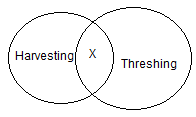
(a) X represents a sickle, which is used to manually harvest crops.
(b) X represents a combine machine, which functions both as a harvester and thresher.
(c) X represents a harvester, which is used to separate seed from chaff.
(d) X represents a winnowing machine, which is used to separate grain from chaff.
 View Answer
View Answer 
Ans: (b)
X stands for a combine machine, which can carry out both harvesting and threshing.
Q49: Based on the given flowchart, identify X, Y and Z.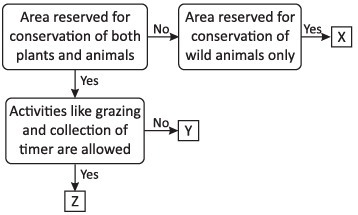 (a) X - Biosphere reserve, Y - Sanctuary, Z - National park
(a) X - Biosphere reserve, Y - Sanctuary, Z - National park
(b) X - Biosphere reserve, Y - National park, Z - Sanctuary
(c) X - Sanctuary, Y - National park, Z - Biosphere reserve
(d) X - National park, Y - Biosphere reserve, Z - Sanctuary
 View Answer
View Answer 
Ans: (c)
Wild sanctuary (X) is the area reserved for conservation of wild animals only, National park (Y) is the area reserved for conservation of both plants and animals. In this area, activities like grazing, and collection of timber are strictly prohibited. Z is biosphere reserve, which is also reserved for conservation of both plants and animals. In these areas, conservation of plants, animals and microorganisms are done along with traditional life forms, living in that area.
Q50: According to the extent of thread to a species and its population in its natural habitat, four categories have been identified which are given below:
(I) Extinct in wild
(II) Critically endangered species
(III) Vulnerable species
(IV) Endangered species Select the correct order of these species according to their conservation priority:
(a) II > IV > I > III
(b) I > II > IV > III
(c) III > I > II > IV
(d) I > IV > III > II
 View Answer
View Answer 
Ans: (b)
An endangered species is a type of organism that is threatened by extinction. These species are very likely to become extinct. Extinct species is a particular animal or plant species that can no longer be available as a wild. Vulnerable species is considered to be facing a risk of extinction in the wild.
FAQs on Science Olympiad Model Test Paper - 1 - Class 8
| 1. What topics are covered in the Science Olympiad Model Test Paper - 1 for Class 8? |  |
| 2. How can I prepare effectively for the Science Olympiad? |  |
| 3. What is the format of the questions in the Science Olympiad Model Test Paper? |  |
| 4. Are there any recommended books or resources for Class 8 Science Olympiad preparation? |  |
| 5. How is the scoring system structured in the Science Olympiad? |  |



















